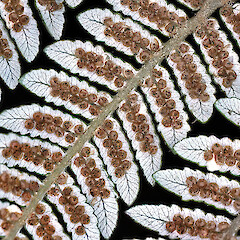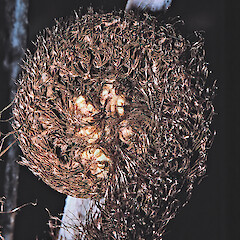Alsophila tricolor
Common name
silver fern, ponga
Synonyms
Cyathea dealbata (G.Forst.) Sw.; Cyathea dealbata var. tricolor (Colenso) Domin; Cyathea tricolor Colenso; Polypodium dealbatum G.Forst.
Family
Cyatheaceae
Flora category
Vascular – Native
Endemic taxon
Yes
Endemic genus
No
Endemic family
No
Structural class
Ferns
NVS code
The National Vegetation Survey (NVS) Databank is a physical archive and electronic databank containing records of over 94,000 vegetation survey plots - including data from over 19,000 permanent plots. NVS maintains a standard set of species code abbreviations that correspond to standard scientific plant names from the Ngä Tipu o Aotearoa - New Zealand Plants database.
CYADEA
Chromosome number
2n = 138, 144
Current conservation status
The conservation status of all known New Zealand vascular plant taxa at the rank of species and below were reassessed in 2017 using the New Zealand Threat Classification System (NZTCS) – more information about this can be found on the NZTCS website. This report includes a statistical summary and brief notes on changes since 2012 and replaces all previous NZTCS lists for vascular plants.
Please note, threat classifications are often suggested by authors when publications fall between NZTCS assessment periods – an interim threat classification status has not been assessed by the NZTCS panel.
- Conservation status of New Zealand indigenous vascular plants, 2017 . 2018. Peter J. de Lange, Jeremy R. Rolfe, John W. Barkla, Shannel P. Courtney, Paul D. Champion, Leon R. Perrie, Sarah M. Beadel, Kerry A. Ford, Ilse Breitwieser, Ines Schönberger, Rowan Hindmarsh-Walls, Peter B. Heenan and Kate Ladley. Department of Conservation. Source: NZTCS and licensed by DOC for reuse under the Creative Commons Attribution 4.0 International licence.
2017 | Not Threatened
Previous conservation statuses
2012 | Not Threatened
2009 | Not Threatened
2004 | Not Threatened
Brief description
Tree fern with green-stalked soft leaves to 4 m long that are distinctly silver on the underside. Trunk to 10 m tall, covered by the bases of old fronds. Leaf stems covered in wavy hairs (lens needed). Sporangia arranged in small round capsules underneath leaves.
Distribution
Endemic. New Zealand: Manawatāwhi / Three Kings Islands south to Mahers Swamp in the west and Dunedin in the east of the South Island.
Habitat
Common, primarily coastal and lowland habitats but extending to lower montane. Preferring dry forest and shrubland, often under pines.
Wetland plant indicator status rating
Information derived from the revised national wetland plant list prepared to assist councils in delineating and monitoring wetlands (Clarkson et al., 2021 Manaaki Whenua – Landcare Research Contract Report LC3975 for Hawke’s Bay Regional Council). The national plant list categorises plants by the extent to which they are found in wetlands and not ‘drylands’. The indicator status ratings are OBL (obligate wetland), FACW (facultative wetland), FAC (facultative), FACU (facultative upland), and UPL (obligate upland). If you have suggestions for the Wetland Indicator Status Rating, please contact: [Enable JavaScript to view protected content]
UPL: Obligate Upland
Rarely is a hydrophyte, almost always in uplands (non-wetlands).
Detailed description
Tree fern up to 10 m tall (very rarely without trunk). Trunk covered in long-persistent, peg-like, stipe bases. Stipes slender, silvery-white when young, maturing pale brown. Harsh to the touch, covered in pale-brown scales. Scales without marginal spines. Fronds up to 4 m long, horizontal, somewhat arching, 3-pinnate. Dead fronds falling. Longest primary pinnae 300–550 mm, pale green above, white below (very rarely pale green) below. Under surfaces sparingly clad in curly hairs. Indusia covering sori at maturity, opening at maturity to form a deep cup with a smooth rim.
Similar taxa
Distinctive. In New Zealand Alsophila tricolor could only be confused with the Raoul Island (Kermadec Islands) endemic A. milnei which is occasionally cultivated on the New Zealand mainland. A. milnei is easily recognised by the pale green rather than white frond under surfaces, and by the persistent skirt of dead fronds. It is rather cold sensitive. Some populations of Alsophila tricolor at Te Paki (and less commonyl elsewhere in northern New Zealand) are distinctive because their fronds have pale grey rather than silvery white under sides and often these plants have a creeping, trunk less (or nearly trunk less) habit. Their status needs further investigation, especially as this form can be found at Te Paki growing alongside A. tricolor plants with a well defined trunk and silvery-white frond under sides. The Te Paki form retains its trunk less (or short trunk) and pale grey frond undersides in cultivation. It is very slow growing.
Flowering
Not applicable—spore producing
Flower colours
No flowers
Fruiting
Not applicable—spore producing
Propagation technique
Can be grown from fresh spores (but slow). Young plants transplant easily and freshly felled trunks will usually resprout if planted and carefully watered. Easy, once established in a varieity of conditions. Should not be removed from the wild unless with the landowners permission.
Threats
Not threatened—widespread and common through most of its range and often seen in urban vegetation. Probably one of the most common, if not the most common, indigenous tree ferns.
Taxonomic Notes
Alsophila tricolor (Colenso) R.M.Tryon is the correct name for Cyathea dealbata (G.Forst.) Sw. in Alsophila. This is because the epithet “dealbata” is preoccupied in Alsophila by A. dealbata C.Presl described in 1848, and now treated as a synonym of Sphaeropteris glauca (Blume) R.M.Tryon.
Where To Buy
Sold by most commericial nurseries. Commonly cultivated.
Attribution
Fact sheet prepared for NZPCN by P.J. de Lange March 2004. Description adapted from Brownsey & Smith-Dodsworth (2000).
References and further reading
Brownsey PJ, Smith-Dodsworth JC. 2000. New Zealand Ferns and Allied Plants. David Bateman, Auckland, NZ. 168 p.
NZPCN Fact Sheet citation
Please cite as: de Lange, P.J. (Year at time of access): Alsophila tricolor Fact Sheet (content continuously updated). New Zealand Plant Conservation Network. https://www.nzpcn.org.nz/flora/species/alsophila-tricolor/ (Date website was queried)








